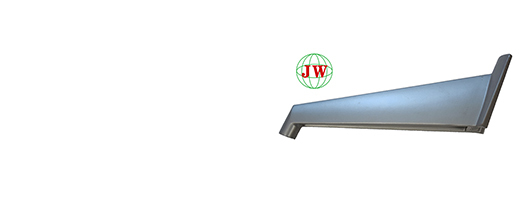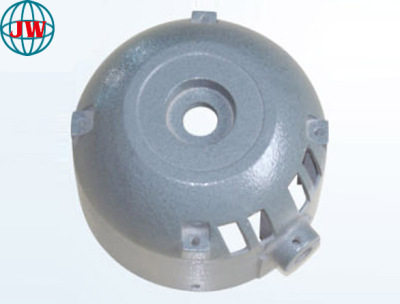
Powder-Coated Die-Cast Parts: Merging Durability and Aesthetics in Modern Manufacturing
2025-07-18 16:35
In the realm of industrial manufacturing, powder-coated die-cast parts have emerged as a game-changer, blending the structural prowess of die casting with the protective and decorative benefits of powder coating. From automotive componentsto household appliances, these hybrid parts are redefining standards for durability, cost-efficiency, and visual appeal.
The Synergy of Die Casting and Powder Coating
Die casting—a process where molten metal (typically aluminum, zinc, or magnesium alloys) is forced into a mold under high pressure—creates parts with exceptional precision, uniformity, and structural integrity. This method excels at producing complex geometries with tight tolerances, eliminating the need for extensive post-processing. When paired with powder coating—a dry finishing technique where electrostatically charged powder is applied and cured under heat—the result is a part that resists corrosion, impact, and UV damage while boasting a sleek, customizable surface.
Consider automotive door handles: A zinc die-cast core provides strength to withstand repeated use, while a powder-coated finish in matte black or metallic silver enhances grip and prevents rust, even in harsh weather. Similarly, aluminum die-cast outdoor lighting fixtures, after powder coating, endure rain, humidity, and temperature fluctuations without chipping or fading, outperforming painted alternatives by 3–5 years.
Key Advantages of Die Casting in Powder-Coated Parts
Die casting brings four critical benefits to powder-coated components:
Dimensional Precision: Molds for die casting are engineered to reproduce intricate details—from threaded holes to thin-walled sections—with minimal variation. This precision ensures powder coating adheres uniformly, avoiding uneven thickness that can cause peeling. For example, magnesium die-cast laptop frames, with walls as thin as 0.8mm, achieve a flawless powder coat that aligns perfectly with screen and keyboard components.
Cost Efficiency: The high-volume production capability of die casting reduces per-unit costs significantly. Unlike machining, which wastes material, die casting uses nearly 95% of the metal feedstock. When combined with powder coating—applied in a single pass with minimal waste—manufacturers see up to 30% lower production costs compared to painting or plating.
Material Versatility: Aluminum die casting, the most common variant, offers an ideal base for powder coating due to its lightweight (30% lighter than steel) and natural corrosion resistance. Zinc die casting, valued for its high strength-to-weight ratio, works seamlessly with powder coatings for small parts like hardware fixtures. Even magnesium die casting, prized for its ultra-light properties, pairs well with specialized powders to enhance flame resistance.
Structural Integrity: Die-cast parts have no seams or welds, eliminating weak points where corrosion might start. This monolithic structure ensures the powder coat bonds to a continuous surface, creating a barrier that seals out moisture and contaminants. In industrial pumps, for instance, aluminum die-cast housings with powder coating withstand chemical exposure without degrading.
Powder Coating: Enhancing Performance and Design
Powder coating complements die casting by addressing two key needs: protection and aesthetics. Unlike liquid paints, powder contains no solvents, reducing VOC emissions and environmental impact. It also forms a thicker, more uniform layer—typically 20–100 microns—resistant to scratches, abrasions, and chemical spills.
For consumer goods, color customization is a major draw. Powder-coated die-cast kitchen mixer bases, available in hues from pastels to bold primaries, retain their vibrancy despite daily cleaning. In commercial settings, die-cast retail display racks with textured powder coats (e.g., hammered bronze) combine durability with a premium look, attracting customer attention while withstanding heavy use.
Advancements in powder technology, such as epoxy-polyester hybrids, further boost performance. These formulations adhere strongly to die-cast surfaces, even with minimal pre-treatment, and offer flexibility to accommodate the slight thermal expansion of metal parts—critical for outdoor equipment exposed to extreme temperature swings.
Applications Across Industries
The versatility of powder-coated die-cast parts spans sectors:
Automotive: From die-cast alloy wheels with matte powder coats (reducing brake dust adhesion) to engine brackets that resist oil and heat, these parts balance function and style.
Electronics: Aluminum die-cast smartphone charging docks, powder-coated in soft-touch finishes, prevent fingerprints while dissipating heat efficiently.
Furniture: Outdoor patio sets use zinc die-cast hinges and frames with weather-resistant powder coats, combining rust protection with modern aesthetics.
Medical Devices: Stainless steel die-cast components in diagnostic equipment, powder-coated with antimicrobial formulas, meet strict hygiene standards while enduring frequent sanitization.
Challenges and Innovations
While the pairing of die casting and powder coating is powerful, it requires careful handling. Die-cast parts may have porous surfaces or residual release agents, which can trap air under the powder coat, causing bubbles. To mitigate this, manufacturers now use vacuum die casting to reduce porosity and automated pre-treatment lines (with chemical etching) to ensure optimal powder adhesion.
Innovations like electrostatic powder coating robots further enhance precision, applying consistent layers even on complex die-cast geometries—such as the curved panels of home appliance control knobs. Meanwhile, recyclable powder formulations align with sustainability goals, as overspray is collected and reused, cutting waste by 80% compared to liquid paints.
Future Trends
As demand for durable, low-maintenance products grows, powder-coated die-cast parts are poised to expand into new markets. The rise of electric vehicles, for example, will drive demand for lightweight aluminum die-cast chassis components with powder coats that resist road salts and debris. In consumer tech, magnesium die-cast wearables with custom powder colors will cater to personalization trends.
Ultimately, the fusion of die casting’s engineering excellence and powder coating’s protective flair proves that in manufacturing, strength and beauty need not be mutually exclusive. For industries seeking to elevate product performance and aesthetics, powder-coated die-cast parts are the clear choice.
Get the latest price? We'll respond as soon as possible(within 12 hours)












